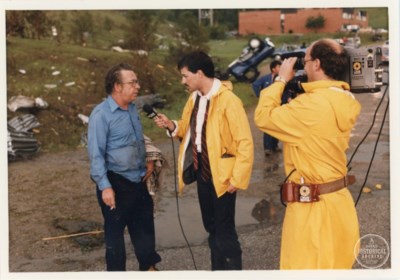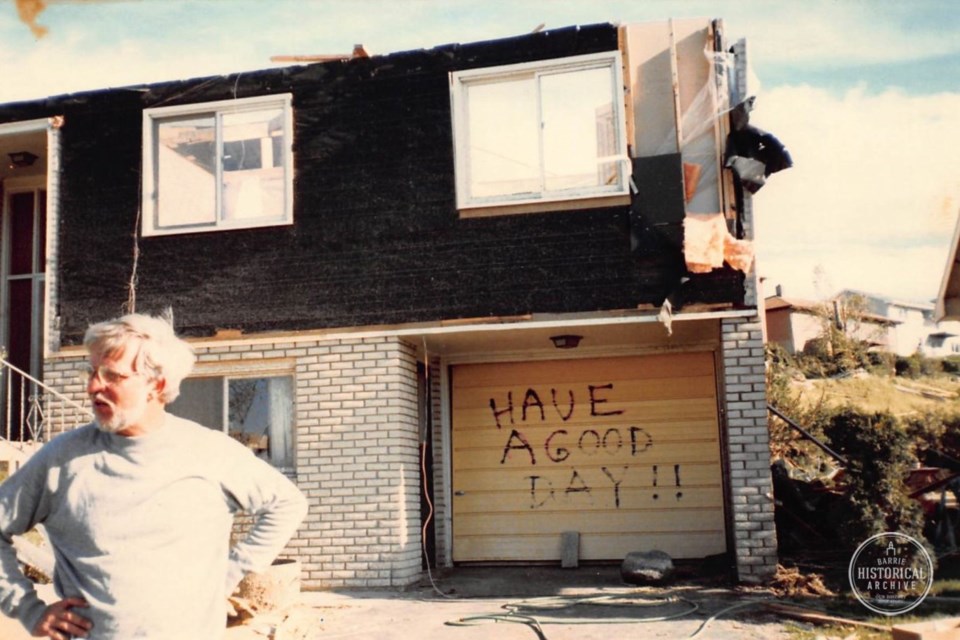It came from the west, dropping from the sky like a bomb dropped onto the homes and businesses in the Patterson and Morrow Road area, churning and raging, sending glass bursting everywhere and reducing timber to toothpicks. What many men built in weeks, a natural phenomenon dismantled in seconds.
Wilhelmina Shoneveld was having a meal with a visitor from Holland when the winds picked up, and soon the conversation turned to the wild weather outside. Canadians are used to intense summer thunderstorms and then worried little about them. Wilhelmina remarked, rather spontaneously, that “Every storm has a story to tell.”
Those were her last words. Wilhelmina suffered a sudden heart attack and collapsed. The local destruction made it impossible for an ambulance to reach her home at Patterson Place, and she passed away.
Farther east, in the area known as Allandale Heights, residents were at first mildly inconvenienced by their electricity having been knocked out, and then increasingly fascinated by the ever-intensifying thunderstorm.
They looked out their windows in amazement. Had they ever seen such intense rain before? It was only early evening but the sky had turned green, then black.
Now they looked out their windows in terrified puzzlement. What was that tremendous noise? Stunned, their brains tried to understand why it seemed to be raining all manner of garbage, and how did their home suddenly come to be violently shaking.
Before they could comprehend fully what was happening, all the windows blew out, the roof lifted away and the walls vanished. With the inexplicable suddenly upon them, adrenaline-fuelled raw instinct kicked in — save the family and take shelter!
Then it was over. It had lasted a couple of minutes at most.
The first feeling was that of relief. We survived!
That emotion was quickly followed by shock. Upon opening their front doors, assuming it still remained, the people of Allandale Heights soon discovered that the monster that had pummeled their home had also obliterated 300 others in the vicinity.
After the ear-splitting crashing and grinding had stopped, and the terrible roar of the wind carried on to wreak havoc upon another area, all became quiet.
Next came moans, shouts of “Are you okay?”, tears, and the far-off sounds of the first sirens.
 Kevin Frankish and cameraman Steve Miller from CKVR on scene minutes after the tornado hit. Barrie Historical Archive
Kevin Frankish and cameraman Steve Miller from CKVR on scene minutes after the tornado hit. Barrie Historical ArchiveIn the hours afterwards, neighbours helped neighbours the best way they could; searching for missing loved ones, pulling trapped people out from under piles of debris and comforting one another. The emergency services arrived. The CKVR crew, from just up the hill, appeared and recorded the carnage.
Volunteer brigades were formed and issued flashlights and cans of red spray paint. They went on a house-to-house search and marked a large scarlet X on houses they had cleared, finding no people, living or dead, trapped within.
Next came the evacuation. The threat of gas leaks warranted a temporary exodus from the already dangerous enough neighbourhood.
When the residents were allowed back, the efforts to return Allandale Heights to some kind of normal began. The storm had been short-lived. This would prove to be a long and difficult process.
Recently, on a fine sunny Saturday, just short of the 32nd anniversary of the Barrie tornado, I took a walk around the area with long time resident Terry Paddison. Terry is a retired high school teacher, passionate local historian, writer and painter, and a survivor of the EF4 that ripped up his neighbourhood in 1985.
Terry pointed out houses that had been completely destroyed, or had found their entire roof neatly placed in the front yard. He showed me places where the owners were ripped off by contractors who disappeared with insurance money. Other homes were bought up by speculators who built new homes on the existing foundation and sold them for good prices after the traumatized owners couldn’t bear to live there anymore.
A local building boom meant that the better builders were otherwise employed, and so often less than knowledgeable workmen were the ones doing the rebuilding. A strike by the manufacturers of drywall material did not help matters.
But rebuild they did. They endured months of television crews, battles with insurance companies, long processions of disaster tourists snaking along their streets, minor looting, and many strangers and workmen in their homes.
The Allandale folks were also very appreciative of the help offered by the Mennonites, Canadian Forces, Red Cross, multiple local service groups and ordinary kind human beings.
Terry still lives in the home that he and Janet bought new in 1968. They have seen the rise and fall, and rise again, of Allandale. Some of their neighbours never spent another night in their home after May 31, 1985. Others rebuilt and still remain.
Some lost their lives on that pivotal day and are memorialized on a large stone at Shear Park, surrounded by a semi-circle of trees – one for each lost life.
Diane, Terry’s neighbour, was weeding her lawn when we passed by, and shared her late mother-in-law’s prophetic quote. It strikes me that Wilhelmina Shoneveld was exactly right.
Want to learn more? The Barrie Historical Archive invites you to celebrate an unshakable community coming together to rebuild their homes and lives, and their city, on the 32nd anniversary of the Barrie Tornado. Join the archive May 31 at 8:15 or 9:30 p.m. at the Uptown Theatre for a free screening of 'Tornado Tales'.



